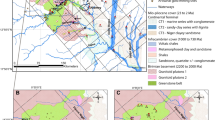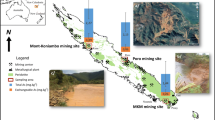Abstract
Historical mining in Alaska has created a legacy of approximately 6,830 abandoned mine sites which include adits, tailing piles and contaminated land that continue to impact surface and groundwater quality through run-off and leaching of potentially toxic metals, especially arsenic (As). One such site is the Lucky Shot Gold Mine in Hatcher Pass, south-central Alaska, which operated from 1920 until 1942, mining gold-bearing quartz veins hosted in a Cretaceous tonalite intrusion. Arsenopyrite (FeAsS) and pyrite (FeS2) present in the quartz veins contribute to elevated As levels in water draining, abandoned mine adits. As future underground mining at Lucky Shot may further adversely impact water quality, baseline geochemical studies were undertaken to assess As mobility in the vicinity of the mine adits. Water samples were collected from streams, adits and boreholes around the mine and analysed for major and minor elements using inductively coupled plasma-mass spectrometry (ICP-MS) and for anions by ion chromatography (IC). Arsenic species separation was performed in the field to determine the ratio of inorganic As(III)/As(V) using anion-exchange chromatography, following established methods. It was determined that water draining the adits had elevated levels of As roughly seventy times the United States Environmental Protection Agency Drinking Water Standard of 10 μg L−1, although this was rapidly diluted downstream in Craigie Creek to <2 μg L−1. Adit and surface water pH was circum-neutral and displayed no characteristics of acid mine drainage. Despite being well oxygenated, As(III) is the dominant As species in adit water, accounting for close to 100 % of total As. The proportion of As(V) increases downstream of the adits, as some As(III) is oxidized, but the speciation enhances arsenic mobility at the site. The δ18O measurements indicate that the water in the system has a short residence time as it is very similar to meteoric water, supporting the observation that the predominance of As(III) in adit water results from the lack of thermodynamical equilibrium being attained and preferential absorbance of As(V).







Similar content being viewed by others
References
Albanese, M., Kline, J. T., Bundtzen, T. K., & Kline, K. (1981). Reconnaissance geology and geochemistry of the Willow Creek-Hatcher Pass Area, Alaska. Public data file 83-9. Technical report, Alaska Division of Geological and Geophysical Surveys.
ASTM International. (2003). ASTM standard D6089. Standard guide for documenting a groundwater sampling event. ASTM international, Technical report.
Bradley, D., Haeussler, P., O’Sullivan, P., Friedman, R., Till, A., Bradley, D., & Trop, J. (2009). Detrital zircon geochronology of cretaceous and Paleogene strata across the south-central Alaskan Convergent Margin. In Haeussler, P. J., and Galloway, J. P., Studies by the U.S. Geological Survey in Alaska, (2007): U.S. Geological Survey Professional Paper 1760-F, 36 p.
Cherry, J., Shaikh, A., Tallman, D., & Nicholson, R. (1979). Arsenic species as an indicator of redox conditions in groundwater. Journal of Hydrology, 43(1–4), 373–392.
Craw, D., & Pacheco, L. (2002). Mobilisation and bioavailability of arsenic around mesothermal gold deposits in a semiarid environment, Otago, New Zealand. The Scientific World Journal, 2, 308–319.
Csejtey, B., Nelson, W. H., Jones, D. L., Siberling, N. J., Dean, R. M., Morris, M. S., et al. (1978). Reconnaissance geologic map & geochronology, Talkeetna mountains quadrangle, Northern part of Anchorage quadrangle, and southwest of Healy quadrangle (pp. 78–558A). Alaska: USGS Open File Report.
Ferguson, J. F., & Gavis, J. (1972). A review of the arsenic cycle in natural waters. Water Research, 6(11), 1259–1274.
Fewtrell, L., Fuge, R., & Kay, D. (2005). An estimation of the global burden of disease due to skin lesions caused by arsenic in drinking water. Journal of Water and Health, 3(2), 101–107.
Haque, S., & Johannesson, K. H. (2006). Arsenic concentrations and speciation along a groundwater flow path: The Carrizo sand aquifer, Texas, USA. Chemical Geology, 228, 57–71.
Henke, K. R. (2009). Arsenic. Environmental chemistry, health threats and waste treatment. Chichester: Wiley.
Jain, C. K., & Ali, I. (2000). Arsenic: Occurrence, toxicity and speciation techniques. Water Research, 34(17), 4304–4312.
Kumar, A. R., & Riyazuddin, P. (2010). Preservation of inorganic arsenic species in environmental water samples for reliable speciation analysis. Trends in Analytical Chemistry, 29, 1212–1223.
Kurtak, J. M. (1986). Results of 1984 Bureau of Mines site specific field studies within the Willow Creek Mining District, Alaska. OFR 17-86. Technical report, Bureau of Mines.
Lett, R. E., Bobrowsky, P., Cathro, M., & Yeow, A. (1998) Geochemical pathfinders for massive sulphide deposits in the Southern Kootenay Terrane. In Geological Fieldwork 1997. Victoria: British Columbia Geological Survey, pp. 15.1–15.9.
Madden, D. J., Silberman, M. L., & Moore-Nall, A. (1987) Ages and geologic relationships in the Willow Creek Gold Mining District, southwestern Talkeetna mountains, Southern Alaska. Open file report 87-143. Technical report, U.S. Geological Survey.
Miller, B. A. (1970). Gold mining in Hatcher Pass. Philadelphia: B. Miller.
Misra, K. C. (2000). Understanding mineral deposits. Dordrecht: Kluwe.
Mok, W. M., Riley, J. A., & Wai, C. M. (1988). Arsenic speciation and quality of groundwater in a lead-zinc mine, Idaho. Water Research, 22(6), 769–774.
Munk, L., Hagedorn, B., & Sjostrom, D. (2011). Seasonal fluctuations and mobility of arsenic in groundwater resources, Anchorage, Alaska. Applied Geochemistry, 26(11), 811–1817.
Neumann, R. B., Ashfaque, K. N., Badruzzaman, A. B. M., Ali, M. A., Shoemaker, J. K., & Harvey, C. F. (2010). Anthropogenic influences on groundwater arsenic concentrations in Bangladesh. Nature Geosciences Journal, 3, 46–53.
Ray, R. G. (1954) Geology and ore deposits of the Willow Creek Mining District Alaska. Geological Survey Bulletin 1004. Technical report, U.S. Geological Survey.
Robertson, F. N. (1989). Arsenic in ground-water under oxidizing conditions, south-west United States. Environmental Geochemistry and Health, 11, 171–176.
Smedley, P. L., & Kinniburgh, D. G. (2002). A review of the source, behaviour and distribution of arsenic in natural waters. Applied Geochemistry, 17, 517–568.
Stevens, D. L. (2010). Lucky Shot project. National instrument 43-101. Technical Report, Harmony Gold Corp.
Stoll, W. M. (1997). Hunting for Gold in Alaska’s Talkeetna mountains, 1897–1951. Ligonier: William M. Stoll.
USEPA. (1994). EPA method 200.8, revision 5.4. Cincinnati: U.S. Environmental Protection Agency.
Van Wyck, N., & Norman, M. (2005). Detrital zircon dates as a constraint on the age of Metasedimentary Rocks in the Hatcher Pass Area, South-central Alaska. In Geological society of America abstract with programs, pp. 82.
Verplank, P. L., Mueller, S. H., Goldfarb, R. J., Nordstrom, D. K., & Youcha, E. K. (2008). Geochemical controls of elevated arsenic concentrations in groundwater, Ester Dome, Fairbanks District, Alaska. Chemical Geology, 255, 160–172.
Welch, A. H., Lico, M. S., & Hughes, J. L. (1988). Arsenic in ground water of the Western United States. Ground Water, 36(3), 333–347.
Wendt, R. (1992). Hatcher pass gold. A historical guide to the Willow Creek mines. Wasilla: Goldstream Publications.
Wilkie, J. A., & Hering, J. G. (1998). Rapid oxidation of geothermal Arsenic(III) in stream waters of the Eastern Sierra Nevada. Environmental Science and Technology, 32(5), 657–662.
Acknowledgments
Fieldwork was funded through a travel grant from the Mac Robertson Scholarship Fund. We would like to express our gratitude to William Burnett, Scott Eubanks for access to the mine site and Jeremy Stariwat of Terrasat Inc. for assistance with sampling.
Author information
Authors and Affiliations
Corresponding author
Rights and permissions
About this article
Cite this article
Torrance, K., Keenan, H., Munk, L. et al. Arsenic speciation and mobility in surface water at Lucky Shot Gold Mine, Alaska. Environ Geochem Health 34, 711–723 (2012). https://doi.org/10.1007/s10653-012-9490-y
Received:
Accepted:
Published:
Issue Date:
DOI: https://doi.org/10.1007/s10653-012-9490-y




